Dispersion Characteristics of Hazardous Gas and Exposure Risk Assessment in a Multiroom Building Environment
Abstract
1. Introduction
2. Model Validation
2.1. Description of the Wind-tunnel Experiment
2.2. CFD Simulation Settings
2.3. CFD Validation: Grid Independent Tests and Comparisons
3. Configuration Descriptions
3.1. Model Setup
3.2. Data Analysis Methods
4. Results
4.1. Non-dimensional Ventilation Rate
4.2. Velocity Distribution under Five Ventilation Paths
4.3. Impact of the Ventilation Path on the Concentration Field
4.4. Impact of Outdoor Source Location on Concentration Field
4.5. Impact of the Source Strength on Human Death Probability
5. Conclusions
- (1)
- Two commonly used wall porosities (5% and 10%) were considered in this study, and the effect is not significant under the presented two wall porosities. The effect of wall porosity under a wider range may not be overlooked, which deserve further investigations. The room under the cross-ventilation condition has a much larger value than that of under the single-sided ventilation condition, while the room located on the windward side also has a larger value than that on the leeward side room, regardless of the ventilation path.
- (2)
- The indoor velocity and concentration fields are obviously different under the five natural ventilation paths. In the view of velocity field, VP2 corresponds to the worst ventilation path. However, VP2 corresponds to the best ventilation path in the view of concentration field. Under VP2, the pollutant concentration in the windward room is approximately 4 times that in the leeward room. The single-outlet ventilation path will affect the airflow distribution in the wake area of the building and then the concentration distribution in R3. The room-averaged concentration in R3 leads to the following ranking from the lowest to the highest: under VP2 (taken as the reference value), under VP5 (27.0% higher) and under VP4 (45.9% higher).
- (3)
- The pollutant concentration in the building decreases significantly with the increase of the lateral distance from the source point to the building. The value of the pollutant concentration under VP2 is the lowest when the pollutant is leaked at y = 0 W. However, the pollutant concentrations entering R2 and R3 under VP2 are higher than those under VP1 and VP5 when the pollutant is leaked at y = 0.5 W and 1 W.
- (4)
- To further assess the potential exposure risk to the indoor personnel caused by the leakage of H2S, the dose-response model is used to quantify the impact of the source strength on the injury of indoor personnel. Under the same ventilation path, when the source strength is changed to be two times larger, the related mortality rate increases from 1% to 99%. The corresponding source strength is changed by approximately four times when both the highest concentration room and all the rooms reach the same mortality rate.
Author Contributions
Funding
Conflicts of Interest
References
- Coker, E.; Kizito, S. A narrative review on the human health effects of ambient air pollution in Sub-Saharan Africa: An urgent need for health effects studies. Int. J. Environ. Res. Public Health. 2018, 15, 427. [Google Scholar] [CrossRef] [PubMed]
- Ribalta, C.; Koivisto, A.J.; Salmatonidis, A.; López-Lilao, A.; Monfort, E.; Viana, M. Modeling of High Nanoparticle Exposure in an Indoor Industrial Scenario with a One-Box Model. Int. J. Environ. Res. Public Health. 2019, 16, 1695. [Google Scholar] [CrossRef] [PubMed]
- Tan, W.; Li, C.; Wang, K.; Zhu, G.; Wang, Y.; Liu, L. Dispersion of carbon dioxide plume in street canyons. Process Saf. Environ. Protect. 2018, 116, 235–242. [Google Scholar] [CrossRef]
- Yang, J.; Li, F.; Zhou, J.; Zhang, L.; Huang, L.; Bi, J. A survey on hazardous materials accidents during road transport in China from 2000 to 2008. J. Hazard. Mater. 2010, 184, 647–653. [Google Scholar] [CrossRef] [PubMed]
- Ditta, A.; Figueroa, O.; Galindo, G.; Yie-Pinedo, R. A review on research in transportation of hazardous materials. Socio-Econ. Plan Sci. 2018, 68, 100665. [Google Scholar] [CrossRef]
- Leung, D.Y. Outdoor-indoor air pollution in urban environment: challenges and opportunity. Front. Environ. Sci. 2015, 2, 69. [Google Scholar] [CrossRef]
- Bernatik, A.; Zimmerman, W.; Pitt, M.; Strizik, M.; Nevrly, V.; Zelinger, Z. Modelling accidental releases of dangerous gases into the lower troposphere from mobile sources. Process Saf. Environ. Protect. 2008, 86, 198–207. [Google Scholar] [CrossRef]
- Zhang, J.W.; Lei, D.; Feng, W.X. Analysis of chemical disasters caused by release of hydrogen sulfide-bearing natural gas. Procedia Eng. 2011, 26, 1878–1890. [Google Scholar]
- Manca, D.; Brambilla, S. Complexity and uncertainty in the assessment of the Viareggio LPG railway accident. J. Loss Prev. Process Ind. 2010, 23, 668–679. [Google Scholar] [CrossRef]
- Nikas, K.S.; Nikolopoulos, N.; Nikolopoulos, A. Numerical study of a naturally cross-ventilated building. Energy Build. 2010, 42, 422–434. [Google Scholar] [CrossRef]
- Shetabivash, H. Investigation of opening position and shape on the natural cross ventilation. Energy Build. 2015, 93, 1–15. [Google Scholar] [CrossRef]
- Chu, C.R.; Chiu, Y.H.; Tsai, Y.T.; Wu, S.L. Wind-driven natural ventilation for buildings with two openings on the same external wall. Energy Build. 2015, 108, 365–372. [Google Scholar] [CrossRef]
- Mavroidis, I.; Griffiths, R.F.; Hall, D.J. Field and wind tunnel investigations of plume dispersion around single surface obstacles. Atmos. Environ. 2003, 37, 2903–2918. [Google Scholar] [CrossRef]
- Kao, H.M.; Chang, T.J.; Hsieh, Y.F.; Wang, C.H.; Hsieh, C.I. Comparison of airflow and particulate matter transport in multi-room buildings for different natural ventilation patterns. Energy Build. 2009, 41, 966–974. [Google Scholar] [CrossRef]
- Liu, X.; Wu, X.; Chen, L.; Zhou, R. Effects of Internal Partitions on Flow Field and Air Contaminant Distribution under Different Ventilation Modes. Int. J. Environ. Res. Public Health. 2018, 15, 2603. [Google Scholar] [CrossRef]
- Lo, L.J.; Novoselac, A. Cross ventilation with small openings: Measurements in a multi-zone test building. Build. Environ. 2012, 57, 377–386. [Google Scholar] [CrossRef]
- Chung, K.C.; Hsu, S.P. Effect of ventilation pattern on room air and contaminant distribution. Build. Environ. 2001, 36, 989–998. [Google Scholar] [CrossRef]
- Mu, D.; Shu, C.; Gao, N.; Zhu, T. Wind tunnel tests of inter-flat pollutant transmission characteristics in a rectangular multi-storey residential building, part B: Effect of source location. Build. Environ. 2017, 114, 281–292. [Google Scholar] [CrossRef]
- Chang, T.J. Numerical evaluation of the effect of traffic pollution on indoor air quality of a naturally ventilated building. J. Air Waste Manag. Assoc. 2002, 52, 1043–1053. [Google Scholar] [CrossRef][Green Version]
- Tong, Z.; Chen, Y.; Malkawi, A. Defining the Influence Region in neighborhood-scale CFD simulations for natural ventilation design. Appl. Energy. 2016, 182, 625–633. [Google Scholar] [CrossRef]
- Pontiggia, M.; Derudi, M.; Alba, M.; Scaioni, M.; Rota, R. Hazardous gas releases in urban areas: assessment of consequences through CFD modelling. J. Hazard. Mater. 2010, 176, 589–596. [Google Scholar] [CrossRef] [PubMed]
- Argyropoulos, C.D.; Ashraf, A.M.; Markatos, N.C.; Kakosimos, K.E. Mathematical modelling and computer simulation of toxic gas building infiltration. Process Saf. Environ. Protect. 2017, 111, 687–700. [Google Scholar] [CrossRef]
- Zhang, B.; Chen, G.M. Quantitative risk analysis of toxic gas release caused poisoning—A CFD and dose–response model combined approach. Process Saf. Environ. Protect. 2010, 88, 253–262. [Google Scholar] [CrossRef]
- Qian, H.; Li, Y.; Nielsen, P.V.; Huang, X. Spatial distribution of infection risk of SARS transmission in a hospital ward. Build. Environ. 2009, 44, 1651–1658. [Google Scholar] [CrossRef]
- Gao, N.P.; Niu, J.L.; Perino, M.; Heiselberg, P. The airborne transmission of infection between flats in high-rise residential buildings: tracer gas simulation. Build. Environ. 2008, 43, 1805–1817. [Google Scholar] [CrossRef]
- Karava, P.; Stathopoulos, T.; Athienitis, A.K. Airflow assessment in cross-ventilated buildings with operable façade elements. Build. Environ. 2011, 46, 266–279. [Google Scholar] [CrossRef]
- Zhu, Y.; Chen, G.M. Simulation and assessment of SO2 toxic environment after ignition of uncontrolled sour gas flow of well blowout in hills. J. Hazard. Mater. 2010, 178, 144–151. [Google Scholar] [CrossRef]
- Tauseef, S.M.; Rashtchian, D.; Abbasi, S.A. CFD-based simulation of dense gas dispersion in presence of obstacles. J. Loss Prev. Process Ind. 2011, 24, 371–376. [Google Scholar] [CrossRef]
- Middha, P.; Hansen, O.R.; Grune, J.; Kotchourko, A. CFD calculations of gas leak dispersion and subsequent gas explosions: validation against ignited impinging hydrogen jet experiments. J. Hazard. Mater. 2010, 179, 84–94. [Google Scholar] [CrossRef]
- Ramponi, R.; Blocken, B. CFD simulation of cross-ventilation flow for different isolated building configurations: validation with wind tunnel measurements and analysis of physical and numerical diffusion effects. J. Wind Eng. Ind. Aerodyn. 2012, 104, 408–418. [Google Scholar] [CrossRef]
- Menter, F. Zonal two equation kw turbulence models for aerodynamic flows. In Proceedings of the 24th AIAA Fluid Dynamics Conference, Orlando, FL, USA, 6–9 July 1993. [Google Scholar]
- Larsen, T.S.; Heiselberg, P. Single-sided natural ventilation driven by wind pressure and temperature difference. Energy Build. 2008, 40, 1031–1040. [Google Scholar] [CrossRef]
- Franke, J.; Hellsten, A.; Schlünzen, H.; Carissimo, B. Best Practice Guideline for the CFD Simulation of Flows in the Urban Environment; University of Hamburg, Meteorological Institute, Centre for Marine and Atmospheric Sciences: Hamburg, Germany, 2007. [Google Scholar]
- Tominaga, Y.; Mochida, A.; Yoshie, R.; Kataoka, H.; Nozu, T.; Yoshikawa, M.; Shirasawa, T. AIJ guidelines for practical applications of CFD to pedestrian wind environment around buildings. J. Wind Eng. Ind. Aerodyn. 2008, 96, 1749–1761. [Google Scholar] [CrossRef]
- Blocken, B.; Stathopoulos, T.; Carmeliet, J. CFD simulation of the atmospheric boundary layer: Wall function problems. Atmos. Environ. 2007, 41, 238–252. [Google Scholar] [CrossRef]
- Tong, Z.; Chen, Y.; Malkawi, A.; Adamkiewicz, G.; Spengler, J.D. Quantifying the impact of traffic-related air pollution on the indoor air quality of a naturally ventilated building. Environ. Int. 2016, 89, 138–146. [Google Scholar] [CrossRef] [PubMed]
- Cermak, J.E. Physical Modelling of Flow and Dispersion Over Complex Terrain. In Boundary Layer Structure; Springer: Dordrecht, The Netherlands, 1984; pp. 261–292. [Google Scholar]
- Uehara, K.; Wakamatsu, S.; Ooka, R. Studies on critical Reynolds number indices for wind-tunnel experiments on flow within urban areas. Bound.-Layer Meteor. 2003, 107, 353–370. [Google Scholar] [CrossRef]
- Kanda, M. Progress in the scale modeling of urban climate: review. Theor. Appl. Climatol. 2006, 84, 23–33. [Google Scholar] [CrossRef]
- Snyder, W.H. Guideline for Fluid Modeling of Atmospheric Diffusion; Environmental Sciences Research Laboratory, Office of Research and Development, US Environmental Protection Agency: Washington, DC, USA, 1981.
- Snyder, W.H. Similarity criteria for the application of fluid models to the study of air pollution meteorology. Bound.-Layer Meteor. 1972, 3, 113–134. [Google Scholar] [CrossRef]
- Britter, R.E. Atmospheric dispersion of dense gases. Annu. Rev. Fluid Mech. 1989, 21, 317–344. [Google Scholar] [CrossRef]
- Center for Chemical Process Safety (CCPS). Guidelines for Consequence Analysis of Chemical Releases; American Institute of Chemical Engineers (AIChE): New York, NY, USA, 1999. [Google Scholar]
- Crowl, D.A.; Louvar, J.F. Chemical Process Safety: Fundamentals with Applications; Prentice Hall: Westford, MA, USA, 2011. [Google Scholar]
- American Society of Heating, Refrigerating, and Air-Conditioning Engineers. ASHRAE Handbook: Fundamentals; American Society of Heating, Refrigerating, and Air-Conditioning Engineers: Atlanta, GA, USA, 2017. [Google Scholar]
- Tian, Z.F.; Tu, J.Y.; Yeoh, G.H.; Yuen, R.K.K. On the numerical study of contaminant particle concentration in indoor airflow. Build. Environ. 2006, 41, 1504–1514. [Google Scholar] [CrossRef]
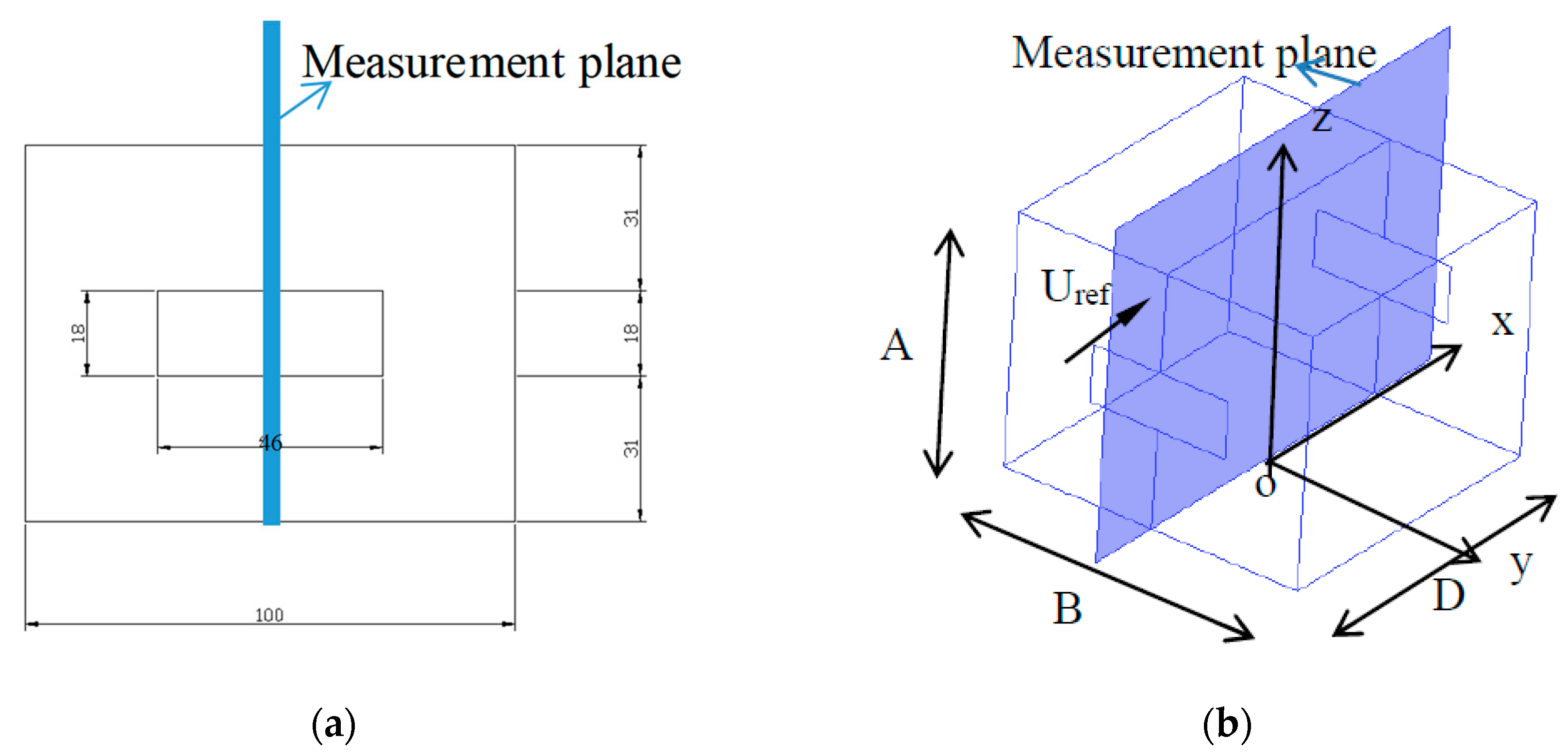
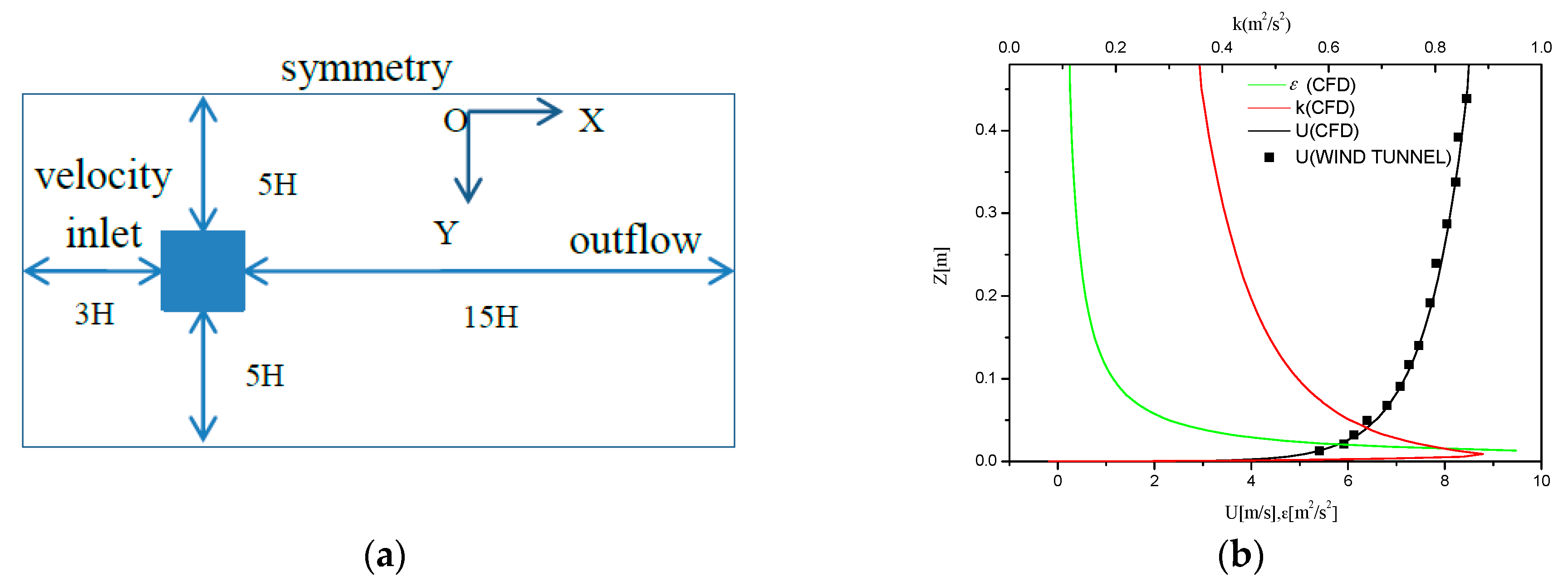
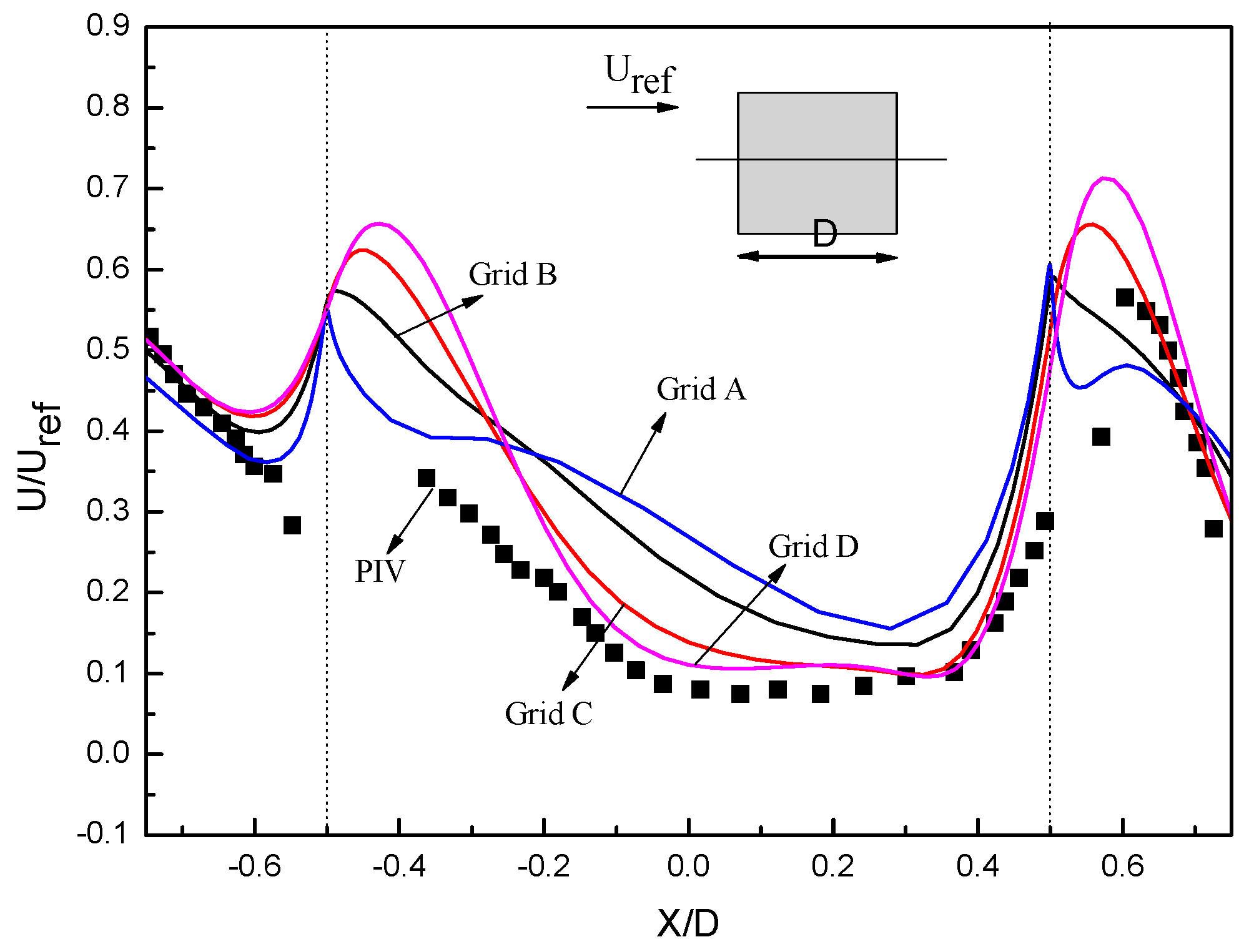


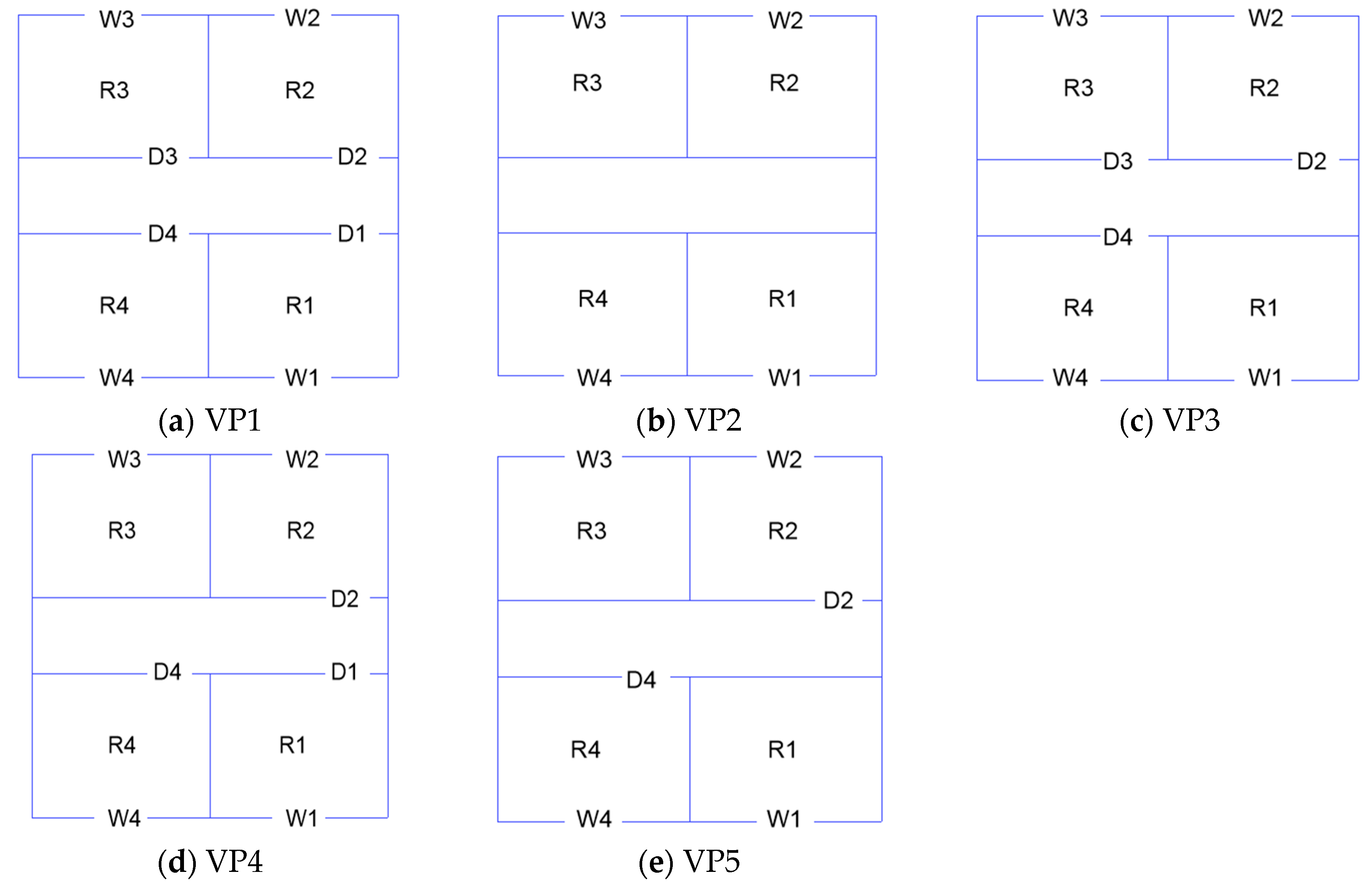
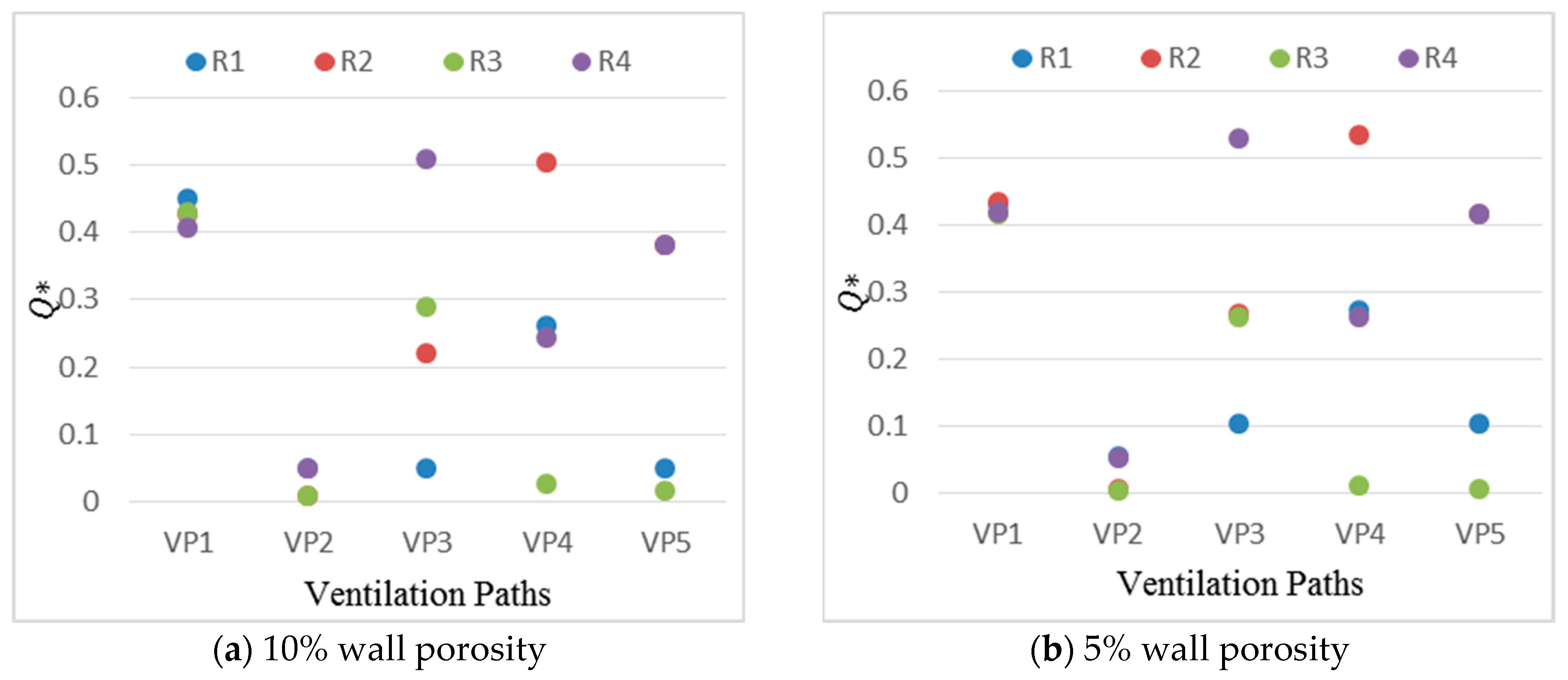
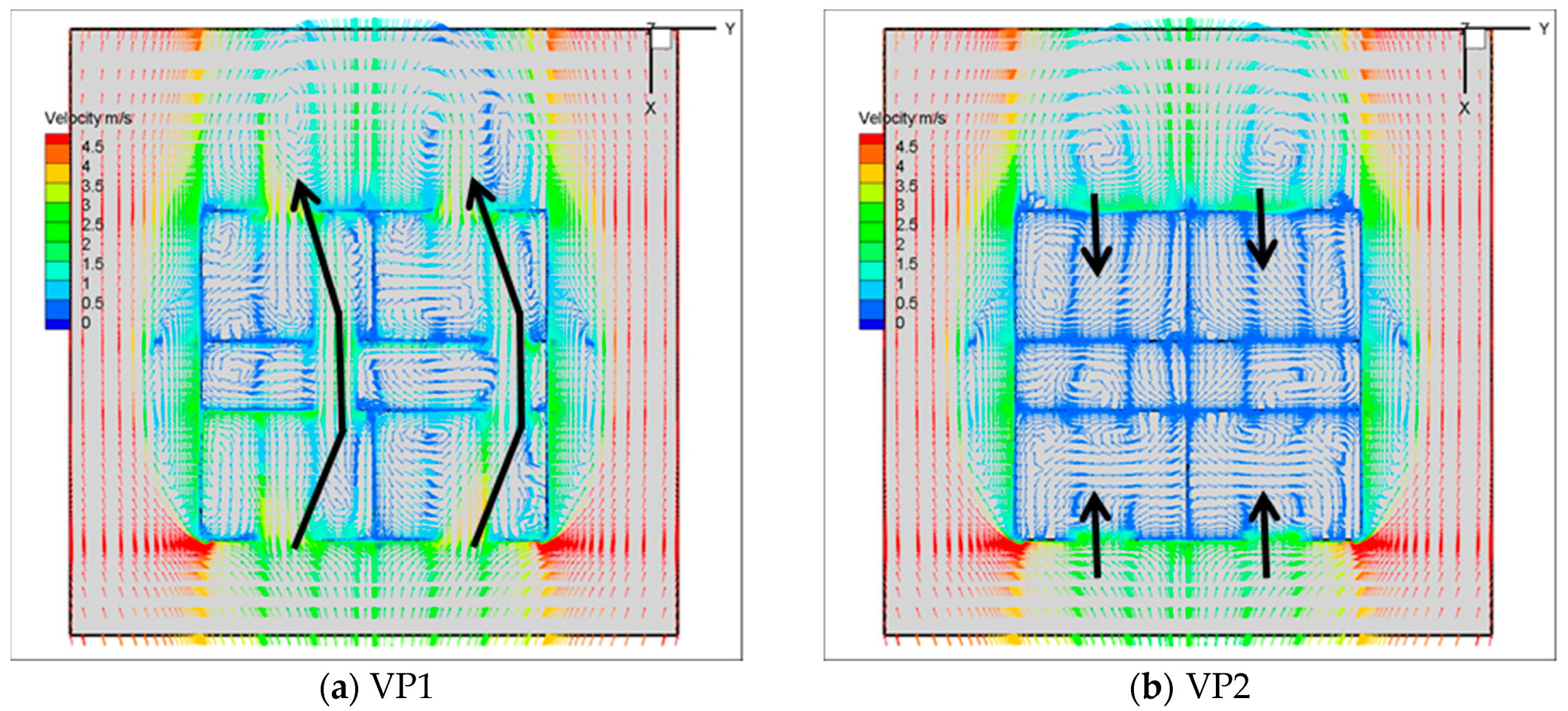
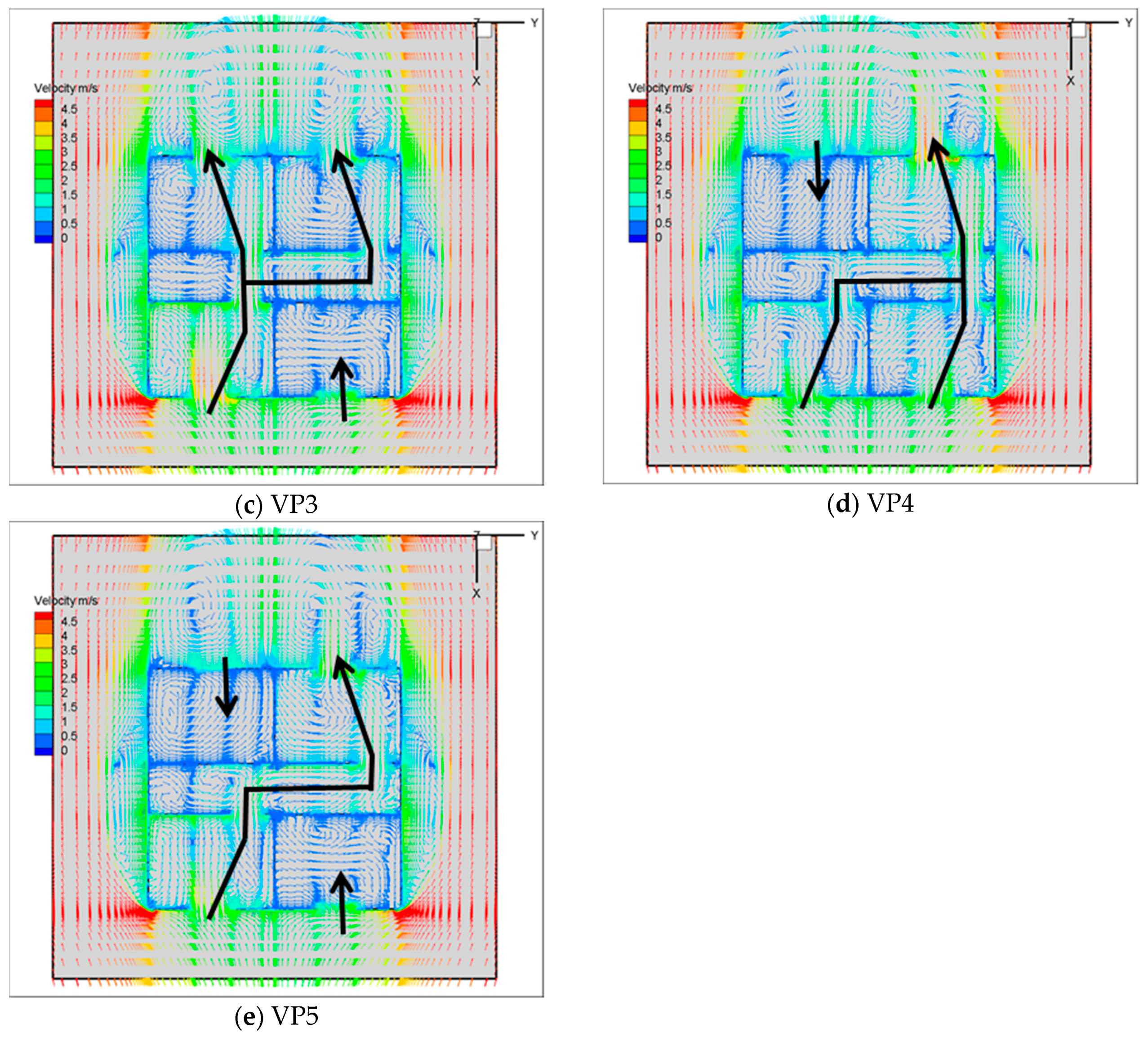
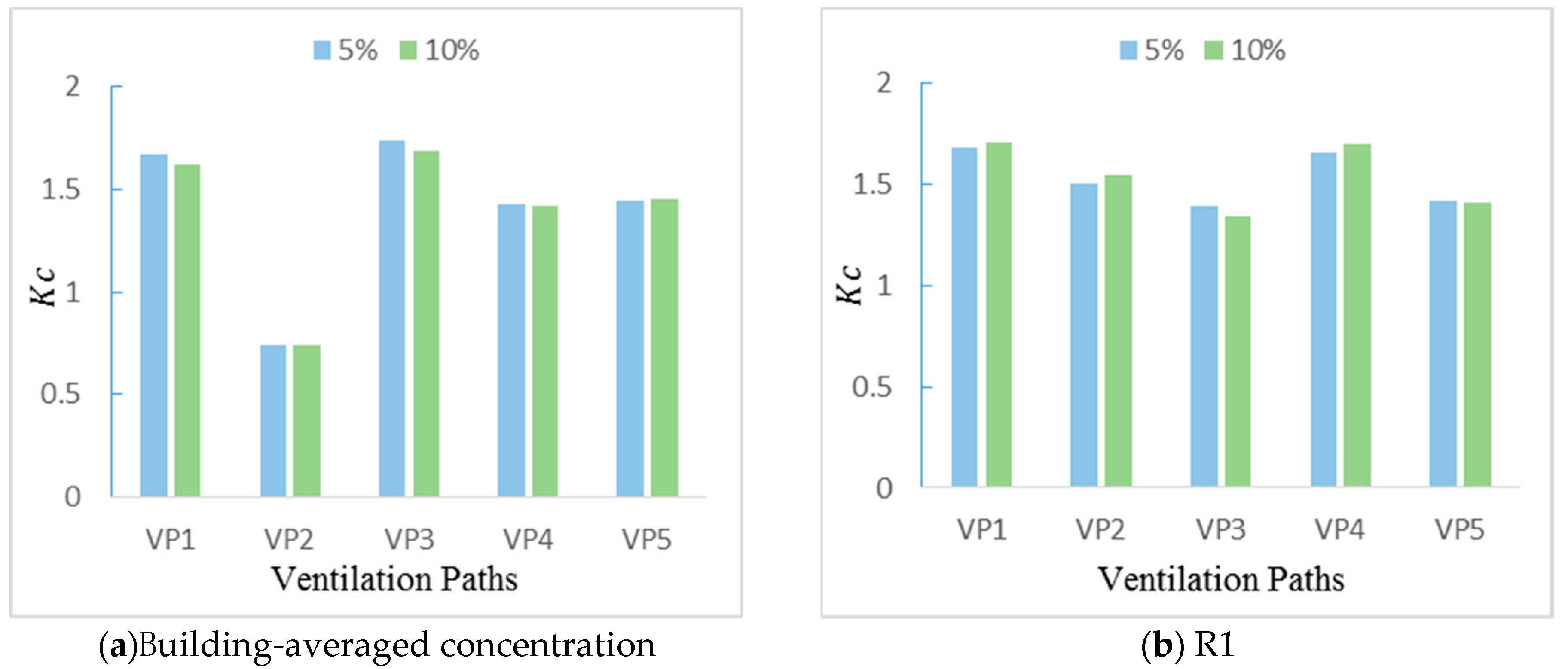
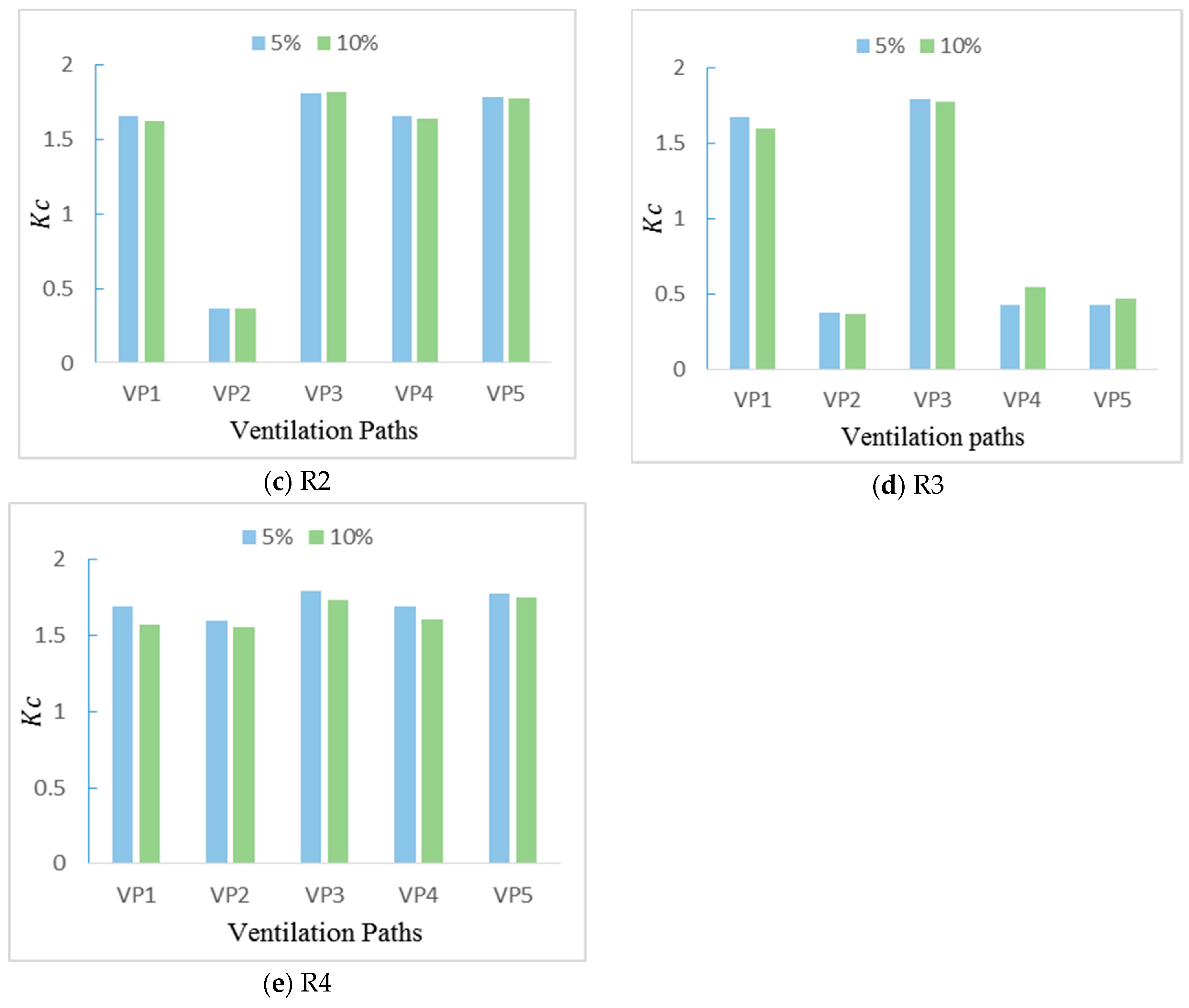
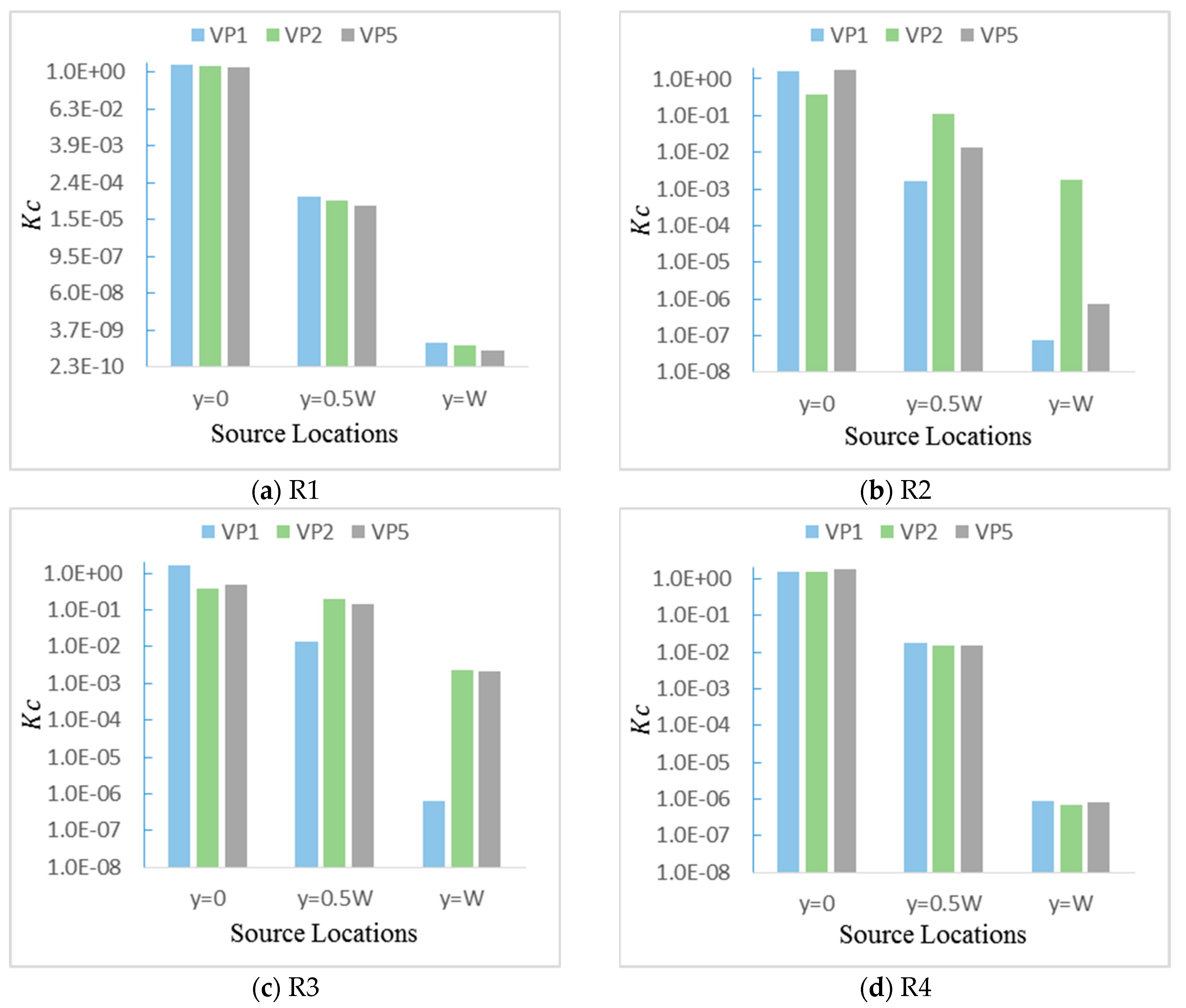
| Case | Source Location | Ventilation Path | Wall Porosity(%) |
|---|---|---|---|
| 1 | y = 0 W | VP1 | 10 |
| 2 | VP2 | 10 | |
| 3 | VP3 | 10 | |
| 4 | VP4 | 10 | |
| 5 | VP5 | 10 | |
| 6 | VP1 | 5 | |
| 7 | VP2 | 5 | |
| 8 | VP3 | 5 | |
| 9 | VP4 | 5 | |
| 10 | VP5 | 5 | |
| 11 | y = 0.5 W | VP1 | 10 |
| 12 | VP2 | 10 | |
| 13 | VP5 | 10 | |
| 14 | y = 1 W | VP1 | 10 |
| 15 | VP2 | 10 | |
| 16 | VP5 | 10 |
| Ventilation Path | Room | Concentration (ppm) | Kc | Corresponding Source Strength That Can Lead to Different Mortality Rates (m3/s) | ||
|---|---|---|---|---|---|---|
| 1% | 50% | 99% | ||||
| VP1 | R1 | 7.72 × 101 | 1.71 × 100 | 7.79 × 10−3 | 1.34 × 10−2 | 2.32 × 10−2 |
| VP2 | R4 | 7.05 × 101 | 1.56 × 100 | 8.53 × 10−3 | 1.47 × 10−2 | 2.54 × 10−2 |
| VP3 | R2 | 8.21 × 101 | 1.82 × 100 | 7.31 × 10−3 | 1.26 × 10−2 | 2.18 × 10−2 |
| VP4 | R1 | 7.69 × 101 | 1.70 × 100 | 7.81 × 10−3 | 1.35 × 10−2 | 2.32 × 10−2 |
| VP5 | R2 | 8.04 × 101 | 1.78 × 100 | 7.47 × 10−3 | 1.29 × 10−2 | 2.22 × 10−2 |
| Ventilation Path | Room | Concentration (ppm) | Kc | Corresponding Source Strength That Can Lead to Different Mortality Rates (m3/s) | ||
|---|---|---|---|---|---|---|
| 1% | 50% | 99% | ||||
| VP1 | R4 | 7.11 × 101 | 1.57 × 100 | 8.45 × 10−3 | 1.46 × 10−2 | 2.51 × 10−2 |
| VP2 | R2 | 1.66 × 101 | 3.66 × 10−1 | 3.63 × 10−2 | 6.25 × 10−2 | 1.08 × 10−1 |
| VP3 | R1 | 6.06 × 101 | 1.34 × 100 | 9.92 × 10−3 | 1.71 × 10−2 | 2.95 × 10−2 |
| VP4 | R3 | 2.44 × 101 | 5.41 × 10−1 | 2.46 × 10−2 | 4.23 × 10−2 | 7.31 × 10−2 |
| VP5 | R3 | 2.13 × 101 | 4.71 × 10−1 | 2.82 × 10−2 | 4.86 × 10−2 | 8.39 × 10−2 |
| Ventilation Path | Room | Concentration (ppm) | Kc | Corresponding Source Strength That Can Lead to Different Mortality Rates (m3/s) | ||
|---|---|---|---|---|---|---|
| 1% | 50% | 99% | ||||
| VP2 | R3 | 9.33 × 100 | 2.06 × 10−1 | 6.44 × 10−2 | 1.11 × 10−1 | 1.91 × 10−1 |
| VP5 | R3 | 6.66 × 100 | 1.47 × 10−1 | 9.02 × 10−2 | 1.55 × 10−1 | 2.68 × 10−1 |
© 2019 by the authors. Licensee MDPI, Basel, Switzerland. This article is an open access article distributed under the terms and conditions of the Creative Commons Attribution (CC BY) license (http://creativecommons.org/licenses/by/4.0/).
Share and Cite
Liu, X.; Peng, Z.; Liu, X.; Zhou, R. Dispersion Characteristics of Hazardous Gas and Exposure Risk Assessment in a Multiroom Building Environment. Int. J. Environ. Res. Public Health 2020, 17, 199. https://doi.org/10.3390/ijerph17010199
Liu X, Peng Z, Liu X, Zhou R. Dispersion Characteristics of Hazardous Gas and Exposure Risk Assessment in a Multiroom Building Environment. International Journal of Environmental Research and Public Health. 2020; 17(1):199. https://doi.org/10.3390/ijerph17010199
Chicago/Turabian StyleLiu, Xiaoping, Zhen Peng, Xianghua Liu, and Rui Zhou. 2020. "Dispersion Characteristics of Hazardous Gas and Exposure Risk Assessment in a Multiroom Building Environment" International Journal of Environmental Research and Public Health 17, no. 1: 199. https://doi.org/10.3390/ijerph17010199
APA StyleLiu, X., Peng, Z., Liu, X., & Zhou, R. (2020). Dispersion Characteristics of Hazardous Gas and Exposure Risk Assessment in a Multiroom Building Environment. International Journal of Environmental Research and Public Health, 17(1), 199. https://doi.org/10.3390/ijerph17010199






